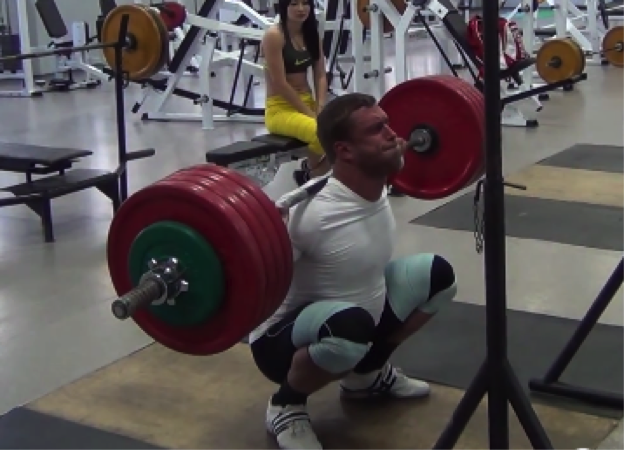Written by Chad Wesley Smith As the Juggernaut Squatapalooza rolls on, check out the first five parts of this series if you’re just tuning in: Part 1: Setting up for a Huge Squat Part 2: Dont Get Stapled – How to Make it Through Your Sticking Point Part 3: 10 Steps to Great Squatting Technique Part 4: Squatting Specifics – What Technique is Best for Your Sport? Part 5: Squatting to Build the Wheels – How Bodybuilders Should Train the Squat
Now lets just get this out of the way up front, the most important things you can do for your squat are squat and squat variations.
The purpose of accessory movements is to complement the primary movement – to build up your unique weak points – so what may be the best accessory work for me may not be the best accessory work for you. You need to critically and honestly evaluate your weak points to decide what areas need extra attention to improve your squatting.
Here are some of my favorite non-squatting movements to build mine and my athletes’ squats:
Box Jumps with a Weight Vest
In my more recent training cycles, I’ve gotten a bit away from these. However, in building my first 900 pound squat, jumps were a cornerstone of my training, and they’re one of my favorite exercises to use with athletes. Weighted jumps are superior to unweighted squats for developing the squat since they will be closer to the competitive movement on the force/velocity curve.
The greatest value in jump training as it relates to the squat is its ability to teach the body to rapidly recruit muscle fibers and quickly produce force. To make sure that you’re getting the maximum training effect from your jumps, whether your jumping from a standing or seated position, try to start from a totally static position (so either sit on the box and don’t allow yourself to rock back to gain momentum, or squat down and pause just above parallel for a 2 count).
With any box jump, it is important to remember that the purpose is to displace the hips as high as possible, not to see how high you can pull your feet up, so focus on landing softly in a parallel or above squat.
Check out this article for more in depth info on how I integrate jumps into my training, Building An Explosive Squat.
Step Ups, Lunges, and Split Squats
For me, step ups, lunges and split squats are basically interchangeable. Great raw squatters have great quad strength, and all three of these exercises will help build the quads, along with improving stability in the ankle and knee.
These unilateral drills, as with any accessory movements, are for building muscle, not testing maxes. Choose a weight that you can do for multiple sets of 6 to 10 reps each leg, while leaving one or two in the tank.
Chest Supported Rows with Isometric Holds
Lat strength is critical to creating a tight setup and supporting heavy weight on your back. There are plenty of great exercises to build lat strength, and I suggest you attack your back from multiple angles.
The chest supported row is a favorite of mine because it allows me to build upper back strength without also taxing my low back, it’s easy to set up and I’m good at them – unlike pullups.
The isometric hold is a great addition to this exercise since your lats are working in an isometric fashion during the squat. On your last rep of each set, hold the weight still at the top of the movement by focusing on squeezing your scapulae together as hard as possible. Make sure you are using your back to hold the weight, not your bicepsbecause your biceps aren’t going to help support a PR squat.
Weighted Carries
Trunk stability and the ability to brace through the core are musts if you want to squat huge weights. Weighted carries include yoke walks, front carries with a keg or sandbag, or farmers carries (double arm or unilateral). Any of these strongman movements will force you to learn how to build great pressure through your trunk, and will put on muscle through high time under tension.
Not only will these movements build ab strength and teach you to brace a neutral spine position. They will also build strength and muscle in the low back, hips and glutes.
Back Raises
I was debating between GHRs and back raises in this spot, as I’ve used both with great success. Back raises, though, I feel have a more direct carryover to my squatting strength, while the real benefit of GHRs was building up my hamstrings for greater tissue approximation and hence rebound out of the hole.
I’m a very quad-dominant squatter, so hamstring strength isn’t playing a huge role in my success, but the strength built with back raises, which have been a staple in my training since high school, has gone a long way in helping me maintain such an upright posture during my squat.
Use the back raise with moderate weight in the 10 to 15 rep range focusing on initiating the movement with a forceful glute contraction and holding the top position of the movement for a 1 count.
Accessory work needs to be unique to each athlete; strategically select movements to bring up your particular weak points. Use movements like these to compliment your primary work, not replace it. Don’t worry about setting accessory work PRs. Rather, just be mindful of how it is aiding your primary lifts. Hopefully these movements that I and my clients use will get you off to a good start on choosing the right exercises for yourself.
Related Articles:













